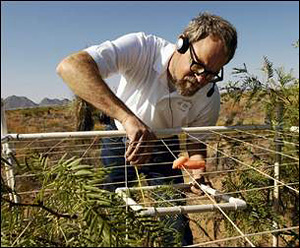 |
 |
 |
 Editorials | Environmental | June 2006 Editorials | Environmental | June 2006  
Research Scientists Work to Unravel Semiarid Landscapes
 NMSU NMSU


| | John Anderson, research site manager with the Jornada Long Term Ecological Research project, measures plant biomass production on the Jornada Experimental Range. Research scientists at the range are tracking the process of desertification on the once widespread grassland. (J. Victor Espinoza/NMSU) |
A team of researchers has developed a multi-faceted process to study arid and semiarid landscapes that takes into account the wide range of factors influencing changes that can result in desertification.

Led by Debra Peters, research scientist for the U.S. Department of Agriculture's Agricultural Research Service at the Jornada Experimental Range in southern New Mexico, the team of USDA and New Mexico State University researchers published their findings in the June 2006 issue of BioScience. The article is titled "Disentangling Complex Landscapes: New Insights Into Arid and Semiarid System Dynamics."

Almost 40 percent of the Earth's surface and 20 percent of the world's population are found in regions that are under threat from desertification, which can result in the loss of grass and degradation of soil as grasslands are converted into woody-plant-dominated landscapes.

Southern New Mexico, which includes part of the vast Chihuahuan Desert, the largest desert in North America, is undergoing desertification in many areas. Historical photos from the Jornada Experimental Range clearly illustrate the dramatic changes that have taken place.

"People don't necessarily realize that this used to be a large grassland," Peters said. Documentation from the experimental range and anecdotal evidence from letters and other accounts include details about the landscape more than 100 years ago. For example, horseback riders reported grass as high as their stirrups.

"It was a huge grassland -- beautiful -- in the 1850s," Peters said. "It hasn't always looked this way."

Although many research methods exist to study various facets of desertification, the USDA/NMSU researchers found that more complete understanding of the process can be achieved by looking back in time at historic legacies, considering environmental factors and studying soil, topography and soil parent material. Also considered is the influence of wind, water and animals as they transport water, nutrients, soil particles, plant litter and seeds. The redistribution of those resources also is weighed in the landscape reorganization.

"Previously we looked at small areas and used that information to make guesses about the large area, to extrapolate to the big area, and that doesn't work very well when things are really complex," Peters said. "And so then we shifted to say, really, the complexity is what's interesting and important."

The researchers offer a six-step operational scheme to unravel the complex influences of these variables. The first step is to "look up" to assess the broad scale, then "look back" in time to determine the role of past events on the present landscape. Third, "look around" to consider adjacent spaces and the influence of wind, water and animals as connecting transport vectors. "Look down" to determine fine-scale properties and processes of the landscape, then integrate the information from broad scale to fine scale to determine the most important influences. Finally, "look forward" in time to the effects of variable environmental factors from the current landscape to the future.

The research may be helpful to ecologists, ranchers, developers, city planners and land managers. Even homeowners in growing areas like Las Cruces can benefit from more information about living in the desert. When Peters speaks to groups of people in the Las Cruces area, she finds they have a great deal of interest in the dynamics of arid and semiarid landscapes. One message she tries to get across is that people can have an impact on arid and semiarid areas.

"We have a lot of people coming in who have never lived in a desert before," Peters said. "There are things that we do that influence what happens here. And they have to realize we can't treat the entire area the same. It depends on where you put your house or what you do when you're out in the desert. Whether you're on a trail or going across the desert, you're going to have an impact, and the impact will vary depending on where you are. Some places are not very sensitive, but other places are very sensitive, so people need to recognize that this is a very heterogeneous landscape. It's actually a very dynamic system."

The research team also includes Jornada Experimental Range research scientists Brandon T. Bestelmeyer, Jeffrey E. Herrick, Ed L. Fredrickson and Kris M. Havstad, and H. Curtis Monger, a professor in the Department of Plant and Environmental Sciences at NMSU. Members of the research team also are part of the Jornada Basin Long Term Ecological Research project funded by the National Science Foundation. | 
 | |
 |



